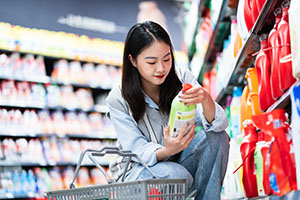
For formulators and manufacturers in the cleaning industry, the drive to remove 1,4-dioxane from finished products has evolved from a regional regulatory issue to a global formulation priority. Once considered an unavoidable trace contaminant, 1,4-dioxane is now squarely in the spotlight due to heightened scrutiny from regulators and consumers alike.
Understanding the Source
1,4-Dioxane is not intentionally added to formulations; it forms as a byproduct during the ethoxylation of surfactants and solvents — a common process used to improve solubility and mildness. Ethoxylated alcohols, fatty acid ethoxylates, and ethanolamines are among the most common sources in both household and industrial cleaners.
The compound’s persistence and classification as a probable human carcinogen have prompted strict limits in several markets. In the U.S., New York State’s Household Cleansing Product regulations set limits as low as 1 ppm for personal care products and 2 ppm for household cleaners, driving reformulation efforts industry-wide.
Formulation Pathways Toward 1,4-Dioxane-Free Systems
Eliminating 1,4-dioxane requires a holistic approach that combines raw material selection, process control, and analytical validation. Formulators are adopting multiple complementary strategies:
- Selecting Non-Ethoxylated Surfactants:
Non-ethoxylated alternatives such as alkyl polyglucosides (APGs), methyl ester sulfonates (MES), sulfonated alpha olefins, and betaines provide strong performance while eliminating the ethoxylation step that generates 1,4-dioxane. - Optimizing Surfactant Blends:
Combining biodegradable surfactants — such as APGs with anionic MES or sulfosuccinates — can deliver synergistic cleaning power and stability across pH and temperature ranges relevant to both I&I and household applications. - Reformulating Solvent Systems:
Replacing ethoxylated solvents (e.g., PEG ethers) with bio-based alternatives like alkyl lactates, glycol ethers derived from renewable feedstocks, or dibasic esters helps avoid contamination while improving sustainability profiles. - Process Control and Supplier Verification:
Working closely with suppliers to ensure stripped or vacuum-treated surfactants (low-1,4-dioxane grades) and tight control of ethoxylation reaction parameters is critical. Quality assurance now often includes routine GC/MS or headspace analysis to verify trace levels below regulatory thresholds. - Using Enzyme and Microemulsion Technologies:
Enzyme-boosted cleaners and microemulsion systems can help offset the loss of certain ethoxylated ingredients by improving soil removal efficiency and surface wetting without requiring traditional ethoxylation chemistry.
Balancing Compliance, Performance, and Cost
While eliminating 1,4-dioxane may initially raise raw material costs or necessitate requalification testing, the long-term benefits — regulatory compliance, cleaner labels, and improved consumer confidence — far outweigh the challenges. The shift also aligns with broader sustainability goals: reducing VOCs, increasing biodegradability, and sourcing renewable materials.
Formulators are increasingly using life cycle assessment (LCA) and green chemistry frameworks to evaluate alternatives, ensuring replacements meet both safety and performance benchmarks. Collaborative innovation between ingredient suppliers and brands is accelerating the introduction of next-generation surfactants engineered to deliver cleaning efficacy without ethoxylation.
The Road Ahead
As more jurisdictions introduce limits and labeling requirements, the ability to design inherently 1,4-dioxane-free systems will become a key differentiator in the cleaning products market. Whether for high-performance industrial degreasers or eco-labeled household detergents, the industry’s focus is clear: build cleaner chemistries from the molecule up.
References & Resources
- U.S. Environmental Protection Agency (EPA). Risk Evaluation for 1,4-Dioxane (2023).
- New York State Department of Environmental Conservation. Household Cleansing Product Information Disclosure Program (2023).
- American Cleaning Institute. Guidance on 1,4-Dioxane and Ethoxylated Surfactants.
- UL Solutions Prospector. Ingredient Search for Low 1,4-Dioxane Surfactants and Solvents.
- European Chemicals Agency (ECHA). Substance Evaluation Report: 1,4-Dioxane.
The views, opinions and technical analyses presented here are those of the author or advertiser, and are not necessarily those of ULProspector.com or UL Solutions. The appearance of this content in the UL Prospector Knowledge Center does not constitute an endorsement by UL Solutions or its affiliates.
All content is subject to copyright and may not be reproduced without prior authorization from UL Solutions or the content author.
The content has been made available for informational and educational purposes only. While the editors of this site may verify the accuracy of its content from time to time, we assume no responsibility for errors made by the author, editorial staff or any other contributor.
UL Solutions does not make any representations or warranties with respect to the accuracy, applicability, fitness or completeness of the content. UL Solutions does not warrant the performance, effectiveness or applicability of sites listed or linked to in any content.
